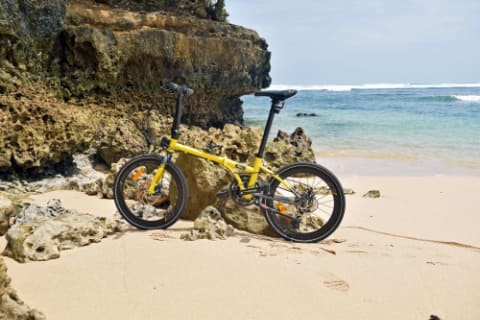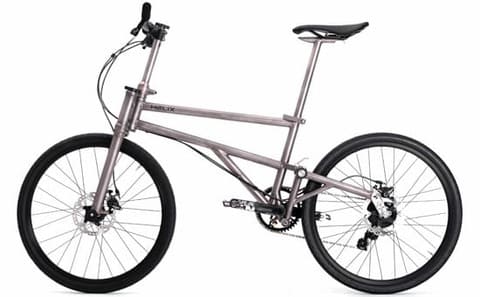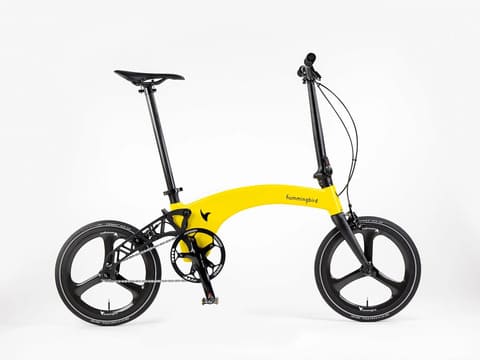As a bicycle frame builder and metallurgist, I’m continually asked what the best material to construct a bicycle frame is. For the most part, it is an irrelevant question. It reflects the efficacy of the marketing hype spewed out by some bicycle manufacturers and a great deal of hearsay and uninformed opinion.
My usual short, glib answer to this question is; it depends.

My first thought in writing this bicycle frames article was to delve into a technical discussion about material science covering specific gravities, tensile strength, alloy jargon, torsional stresses, and the like.
While that type of discussion might be informative, albeit somewhat dry for the reader, it doesn’t yield a practical insight when contemplating a folding bike purchase.
So I’ll just cut to the chase.
Bike Frame Materials Pros And Cons

The most common bike frame materials are aluminum, carbon fiber, steel, and titanium. Here are the pros and cons of each material:
| Bike Frame Material | Pros | Cons |
| Aluminum | Aluminum is three times lighter than steel and is relatively cheap compared to other metals. | Aluminum requires thicker and larger walled tubing due to its low stiffness. |
| Carbon Fiber | A robust and lightweight material that provides a plush ride. | Carbon fiber is expensive and damages easier than metal frames. |
| Steel | A stiff metal that can be lightweight with the correct bike frame design. | Steel frames are typically heavier than other bicycle materials. |
| Titanium | A lightweight material with excellent strength, corrosion resistance, and fatigue life. | Titanium is an expensive metal that is difficult to work with when building frames. |
Aluminum vs. Steel Bike Frames

Everyone knows that aluminum is lighter than steel and roughly 1/3 more lightweight. This leads many people to conclude that an aluminum bike should be considerably lighter than a steel-made bike.
That would be true if the frame tubing used for an aluminum bike and a steel bike were of the exact dimensions, but that is never the case.
Why?
Because aluminum doesn’t have the stiffness of steel, one can’t make a bike with enough structural integrity that uses the same dimensional tubing typically employed to make a steel bike.
Aluminum bikes almost always tend to use larger diameter and thicker walled tubing than steel bikes to compensate for their lack of stiffness. When you dimension up an aluminum bike to gain the required stiffness and structural integrity, you start to approach the weight of a well-made steel bike.
A well-designed steel bike can weigh less than a marginally designed aluminum bike.
Folding Bike Frame Design And Material Selection
Now, these statements apply to bikes in general.
In the case of folding bikes, many are indeed made of aluminum because they are typically smaller than a standard bike and, therefore, can’t use off-the-shelf, high-quality, lightweight double-butted steel tubing.
To keep costs down and to produce an acceptably light bike, folding bike manufacturers use aluminum in their construction rather than steel.
The exception to this statement is some cheaply constructed folding bikes that use low-cost straight gauge steel, which is almost always unacceptably heavy.
As a quick aside, “double-butted” means that a frame tube has been constructed with variable wall dimensions whereby the ends, where the welds are placed, are thicker than the middle.
“Straight gauge” tubes have the same thickness for the length of the tube. Producing double-butted tubes adds considerably to their cost over straight gauge tubes.
Best Bike Frame Material

The strength, corrosion resistance, weight, and fatigue life of titanium make it the best bike frame material. However, as one can readily see from the price of titanium bikes, they are typically quite expensive.
It’s not so much that titanium is an overly expensive and rare metal itself.
It’s just that titanium is a more difficult metal to work with and the bulk of the added expense results from the cost of the equipment used to cut, prepare, and weld a bike frame.
In the case of folding bikes, very few available are made from titanium.
This may change in the future, but you can be assured that they will be considerably more expensive than an aluminum or steel folding bike. You’ll have to decide if the relatively slight bike weight saving is worth the price.
Carbon Fiber Bike Frames

What about carbon fiber, you say?
Well, there is no disputing that carbon fiber is widely used on many road bikes and some mountain bikes where weight is a prime issue. There are very few folding bikes made from carbon fiber.
As with titanium, you’ll have to decide if the weight savings plus perhaps the “cool” factor is worth the price.
However, I recommend against a carbon fiber folding bike since they typically sustain more banging around from transporting. Impact blows can easily damage carbon fiber.
Bike Frame Materials Ride Characteristics
Many times, much discussion about the merits of one bike frame material over another is focused on the bike’s ride characteristics. Terms like springy, whippy, harsh, and soft are bandied about, usually capriciously without a basis.
Some people don’t like aluminum bikes because they claim they have an unacceptable ride quality. Well, that may be the case for that particular bike to which they ride.
Still, such a statement can only be extended to one aluminum bike, generalized to all aluminum bikes, or attributed to the fact that their bike is made from aluminum.
A few years ago, a particularly fussy customer of mine would make all kinds of unsubstantiated claims about the differing ride qualities he attributed to the frame material.
So I made a wager with him.
I bet him that he couldn’t distinguish between steel, aluminum, or titanium-made bike. I selected three bicycles of the same design, put masking tape on the frame to disguise them, and fitted each with the same components (wheels, tires, groupset, handlebars, etc.).
I had him ride each bike twice.
While he was convinced he picked out each bike correctly, he didn’t even pick one. After his rides, I have yet to tell him the results. I told him I would make a minor change on each bike and have him test again.
This time I put different tires on each bicycle.
A firm one, a soft one, and a medium one. I had him test the bikes again. This time his comments on ride quality were precisely in line with the characteristics of the tires.
After I told him the results, he was pretty chagrined. The point is that the tire and wheel setup overwhelms any supposed frame material-induced ride quality factors that may or may not be present.
Bottom Line
The bottom line is that the type of material used to construct a bike is a trivial issue compared to the bike’s design and the components’ quality.
To be sure, when selecting a folding bike, since you will be transporting it in some fashion reasonably often, its weight should be taken into consideration. Therefore, please focus on the folding bike’s overall weight rather than the material used in its construction.
So to conclude, when I say “it depends” when asked the question about frame material, it depends on how lightweight a folding bike you want and how much money you have to spend, not so much on the material itself.
Ride safe! – Peter Whitford, Bicycle Frame Builder & Metallurgist

![Folding Bikes vs Regular Bikes [year]: 7 Surprising Advantages](https://www.foldingbikeguy.com/wp-content/uploads/Folding-Bike-vs-Regular-Bike.jpg)
![How Much Do Folding Bikes Weigh in [year]? Weight Limits Revealed](https://www.foldingbikeguy.com/wp-content/uploads/How-Much-Do-Folding-Bikes-Weigh.jpg)


![Best Lightweight Folding Bike [Year] (8 Lightest Foldables)](https://www.foldingbikeguy.com/wp-content/uploads/Best-Lightweight-Folding-Bike.jpg)
